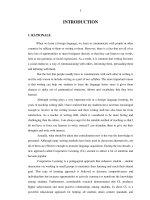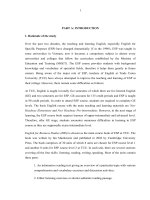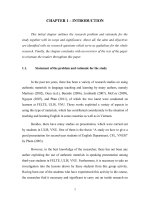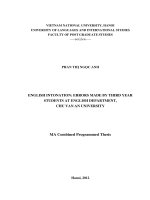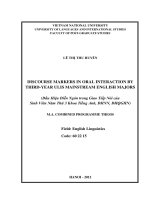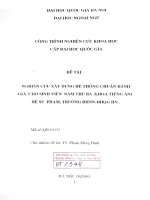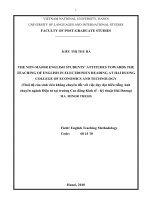Thiết kế chương trình đọc hiểu tiếng Anh chuyên ngành Sử học cho sinh viên năm thứ ba Khoa Xã hội, Trường Cao đẳng Sư phạm Bắc Nin
Bạn đang xem bản rút gọn của tài liệu. Xem và tải ngay bản đầy đủ của tài liệu tại đây (1.13 MB, 54 trang )
vietnam national university, hanoi
college of foreign languages
department of post graduate studies
* * * * * * * * *
NGUYỄN VĂN THUẬT
designing an esp reading syllabus for
third - year students at the social department,
bac ninh teachers’ training college
THIẾT KẾ CHƯƠNG TRÌNH ĐỌC HIỂU
TIẾNG ANH CHUYÊN NGÀNH SỬ HỌC CHO SINH VIÊN NĂM THỨ BA
KHOA XÃ HỘI, TRƯỜNG CAO ĐẲNG SƯ PHẠM BẮC NINH
MINOR THESIS
FIELD: ENGLISH TEACHING METHODOLOGY
CODE: 601410
HANOI - 2009
vietnam national university, hanoi
college of foreign languages
department of post graduate studies
* * * * * * * * *
NGUYỄN VĂN THUẬT
designing an esp reading syllabus for
third - year students at the social department,
bac ninh teachers’ training college
THIẾT KẾ CHƯƠNG TRÌNH ĐỌC HIỂU
TIẾNG ANH CHUYÊN NGÀNH SỬ HỌC CHO SINH VIÊN NĂM THỨ BA
KHOA XÃ HỘI, TRƯỜNG CAO ĐẲNG SƯ PHẠM BẮC NINH
MINOR THESIS
FIELD: ENGLISH TEACHING METHODOLOGY
CODE: 601410
SUPERVISOR: ĐỖ BÁ QUÝ, M.Ed
HANOI - 2009
Tables of contents
Acknowledgement
Abstract
List of abbreviation
List of tables and figures
Part one: Introduction Page
1. Rationale for the study 1
2. Aims and objectives of the study 2
3. Scope of the study 2
4. Method of the study 2
5. Organization of the study 3
Part two: Development
Chapter I: Literature review 4
I. An overview of ESP 4
I.1.1. Definition of ESP 4
I.1.2. Types of ESP 5
I.1.3. General English vs. English for special purpose 7
I.2. An overview of syllabus design 7
I.2.1. Definitions of syllabus 7
I.2.2. Syllabus design 8
I.2.3. Types of syllabus 9
I.2.3.1. Content – based syllabus 9
I.2.3.1.1. Structural syllabus 9
I.2.3.1.2. Notional / functional syllabus 9
I.2.3.1.3. Situational syllabus 9
I.2.3.1.4. Topic - based syllabus 9
I.2.3.2. Skill – based syllabus 10
I.2.3.3. Method – based syllabus 10
I.2.3.3.1. Task – based syllabus 10
I.2.3.3.2. Process syllabus 11
I.3. Needs analysis in syllabus design 11
I.3.1. Needs analysis 11
I.3.2. Types of needs 12
I.3.2.1. Target needs 12
I.3.2.2. Learning needs 13
I.4. An overview of reading 14
I.4.1. Reading skills in ESP 14
I.4.2. Reading skills/ strategies 15
I.5. Summary 16
Chapter II: The study
II.1. Situation analysis 17
II.1.1. The teaching and learning situation at BTTC 17
II.1.2. Resources and Administrative constraints 17
II.1.3. The teachers 18
II.1.4. The students 18
II.2. The study 19
II.2.1 The participants 19
II.2.2. Instrument for collecting data 19
II.3. The findings and discussion 20
II.3.1. Needs perceived by the teachers of the English Department 20
II.3.2. Needs perceived by the 3
rd
year – students of History at the SD 26
II.4. Summary of the findings and discussion 30
Chapter III: Designing an ESP reading syllabus
for the 3
rd
year students of History at the SD, BTTC
III.1. Aims and objectives of the expected reading syllabus 31
III.2. Selecting a type of syllabus for ESP students at the SD, BTTC 32
III.3. Sequencing the content in the syllabus 32
III.3.1. Topics in the syllabus 32
III.3.2. Reading skills and learning activities 33
III.3.3. The organization of the syllabus 34
III.3.4. Designing tests for the ESP reading course 35
III.4. The proposed syllabus for the third - year students at the SD, BTTC 35
III.5. Suggestions for the implementations of the proposed syllabus 37
III.5.1. To the teacher 37
III.5.2. To the student 37
III.5.3. To the material designer 38
Part three: Conclusion
1. Conclusions 39
2. Limitations of the study 39
3. Suggestions for further study 40
Appendix 1: TEACHERS SURVEY QUESTIONNAIRE
Appendix 2: STUDENTS SURVEY QUESTIONNAIRE
REFERENCE
List of abbreviations
BTTC: Bac Ninh Teachers’ Training College
EAP: English for Academic Purposes
EH: English for History
ELT: English Language Teaching
EOP: English for Occupational Purposes
ESP: English for Specific Purposes
GE: General English
NA: Needs Analysis
SD: Social Department
list of tables and figures
Figure 1: ESP classification by experience
Chart1: ESP teachers’ ideas on the current textbook and their opinions on designing a new
ESP reading syllabus
Chart 2: Teachers’opinion about the objectives of the syllabus
Chart 3: Teachers’opinion about the consolidation of grammar in the syllabus
Table1: Teachers’ ranking the objectives of the syllabus in order of importance
Table 2: Teachers’ rating the topics relevant to English for History
Table 3: The teachers’ attitudes to the language and reading exercises
Table 4: Students’ ideas on objectives expected at the end of the reading syllabus
Table 5: Students’ rating the appropriateness of the topics relevant to the syllabus
Table 6: : Students’ opinions of the language and reading exercises
1
Part one: Introduction
1. Rationale for the study
Over the last few decades, together with the development of General English (GE),
English for Specific Purposes (ESP) has become an indispensable branch in English Language
Teaching (ELT) in Vietnam to meet the growing demand for communicating with foreigners
and updating information as well as technology in the fields of computer science and
engineering, electronics, telecommunications, tourism, etc.
Besides, the spread of English as a result of globalization has brought impacts to the
world. As an international language, it is instrumental in enhancing economic, political, social
and diplomatic relations and scientific exchanges between many countries, providing access to
advanced technology and information. According to Crystal (1997), 85% of international
organizations in the world make official use of English, at least 85% of the world film makers
are in English and approximately 90% of published articles in some academic fields are
written in English. For these reasons, the fever of learning English in the world as well as in
Viet Nam has never been abated.
Although people in the above - mentioned areas all speak the same language, they use
it in different environments and for different purposes. English learners need to learn English
for their specific purposes and ELT, therefore, has been showing an inevitable tendency of
shifting from GE to ESP
In addition to his specific purposes, each learner starts an ESP course with his own
background knowledge of the subject matter and his own available competence. Learners of
different - target needs really have different necessities, lacks and wants. These require the
design of special syllabus and special materials for a specific target group of learners.
The syllabus is designed on the ground of the 15
th
decision made by the Ministry of
Education and Training which focuses on renovating the methods of teaching and learning. It
is also based on the plans for the academic school year 2003 - 2004 of Bac Ninh Teacher
Training College (BTTC), one of which aims at changing and improving teaching and learning
methods between teachers and students.
2
Accordingly, designing an ESP reading syllabus for the third – year students has been
an urgent task for the development of ESP teaching and learning at BTTC.
2. Aims and objectives of the study
The study aims at choosing an approach to designing an ESP reading syllabus for a
group of history students who are learning to become teachers of history at lower secondary
schools and who are learning English as a foreign language with a view to reading English
materials.
The researcher defined the major objectives of the study as follows:
- to identify the needs of the third - year history students of the Social Department (SD)
at BTTC.
- to design an ESP reading syllabus for the target students which is relevant to their
needs and requirements for their future jobs.
3. Scope of the study
The study mainly focuses on the designing of an ESP reading syllabus for a group of
students of history at BTTC - SD, who are at pre - intermediate level of English proficiency.
4. Methods of the study
In order to successfully fulfill the tasks and achieve the objectives of the study,
attention should firstly be paid to the kind of syllabus, which would be appropriate for the
target students. Qualitative method is employed in the research by means of survey
questionnaires, informal interviews and document analysis.
To identify students‟ needs and expectation, the useful topics and appropriate learning
tasks and activities in the ESP course to facilitate the design of an ESP reading syllabus for the
third - year of students of history, two questionnaires are employed to the targeted students
and the teaching staff of BTTC, English Department.
To clarify the information collected through the survey questionnaires and to get a
thorough picture of the actual learning and teaching of English at BTTC, informal interviews
with the target students as well as the teachers will be conducted.
Last but not least, constant discussion with the supervisor and colleagues are of great
significance.
3
5. Organization of the study
The study is divided into three parts which are briefly presented as follows:
Part I is the introduction which presents rationale, aims, scope, research method and
organization of the study.
Part II is the development of the study, consisting of the three chapters
- Chapter 1 provides the theory of ESP, course and syllabus design
- Chapter 2 presents the background to the study. Need analysis, including learning
needs and target needs, with data analysis of the study.
- Chapter 3 proposes an ESP reading syllabus based on the findings of the study.
Part III is the conclusion which summarizes the overall study and states its limitations and
suggestions for further research.
4
Part two: Development
Chapter I: Literature review
This chapter will present different definitions of ESP to highlight the characteristics of
an ESP course and factors to be taken into account in designing an ESP course. This chapter
also discuses needs analysis in the syllabus designs.
I.1. An overview of ESP
I.1.1. Definitions of ESP
In fact, there have been a number of definitions for ESP defined by different people
because different people have given different emphases to the variety of elements that
characterize ESP.
Fitzjohn (in Robinson 1980: 9) mentions the time factor as a characteristic feature of ESP. He
states:
The very concept of ‘special purposes’ implies that foreign language study is a
subsidiary contribution to another, main interest, and that there will normally
be pressure to achieve the required level of linguistic competence in the
minimum time.
Pauline Robinson (1991) shared the same idea. One of her features is that ESP courses
are generally constrained by a limited time period. That is the objectives must be achieved
within a short period of time, the learners must obtain the required level of linguistic
competence.
Hutchinson and Waters typically stated:
An ESP syllabus is expressed in terms of aspects language which (a) are
important and appropriate to a specific academic or occupational situation and
(b) meet the needs of the learner. (Hutchinson and Waters, 1987: 13).
Robinson‟s another characteristic is that ESP is taught to adults homogeneous classes in terms
of their work or specialist study. Most of learners in an ESP course are to be adults, not
children. Long cited Robinson (1980: 9) points out:
The number of people wanting to learn English for Special purposes is spiraling.
5
By any large these people have been students in tertiary education, and adults.
Dudleys - Evans and St. John, in a more recent study, have modified Streven‟s definition and
exposit their revised view on the essence of ESP from the following two perspectives: absolute
and variable characteristics.
i. Absolute characteristics:
- ESP is defined to meet specific needs of the learner;
- ESP makes use of the underlying methodology and activities of the discipline it
serves;
- ESP is centred on the language (grammar, lexis and register), skills, discourse and
genres appropriate to these activities.
ii. Variable characteristics:
- ESP may be related to or designed for specific disciplines;
- ESP may use, in specific teaching situations, a different methodology from that of
general English;
- ESP is likely to be designed for adult learners, either at tertiary level institution or in
a professional work situation. It could, however, be for learners at secondary school
level;
- ESP is generally designed for intermediate or advanced students
- Most ESP courses assume some basic knowledge of the language system, but it can
be used with beginners. (Dudleys - Evans and St. John. 1998: 4-5)
In short, all the above presented definitions show that ESP belong to the English language
teaching and that meeting the needs of the learners is the first priority in the teaching of ESP.
For this obvious focus, ESP course designers should base on learners‟ needs to determine the
content of the syllabus, the materials and the teaching method to make the course valuable.
I.1.2. Types of ESP
Traditionally, ESP has been divided into two main areas: English for Occupational Purposes
(EOP) and English for Academic Purposes (EAP). Kennedy and Bolitho (1984: 4) explain the
two areas quite clearly as the followings:
6
EOP is taught in a situation in which learners need to use English as part of their work
or profession. Instances of EOP students would be doctors in casualty or technicians
servicing equipment. They need English, in the first case, to talk and respond to
patients and other staff, and, in the second, to read technical manuals.
EAP is taught generally within educational institution to students needing English in
their studies. The language taught may be based in particular discipline at higher
levels of education when the student is specializing (in - study) or intends to specialize
(pre - study) in particular subject.
Sharing the same view of dividing ESP into EOP and EAP, Robinson (1991: 3 - 4) shows us
the following tree diagram:
Figure1. ESP classification by experience
It is obvious that the division of ESP into EOP and EAP is of great importance, as they
will affect the degree of specificity that is appropriate to the course. (Dudley - Evans and St
John, 1998: 6). A pre - experience or pre - study course will probably rule out any specific
work related to the actual discipline or work as students do not have required familiarity with
the content, while course of in - service or in - study will provide the opportunity for specific
or integrated work.
ESP
EOP
EAP
Pre - experience
Simultaneous / In-service
Post - experience
For study in a
specific discipline
As a school subject
Pre - study
In- study
Post - study
Independent
Integrated
7
In short, studying various types of ESP is an important step for ESP teachers because it
provides them with an overall picture of the group of learners they are going to work with.
Accordingly, it is helpful for ESP teachers to conduct needs analysis, to choose teaching
materials as well as to design an appropriate ESP course for their target students.
I.1.3. General English vs. English for special purposes
In his definition, Streven (1988) pointed out in the absolute characteristic that ESP is in
contrast with GE. In fact, it may raise a matter of concern for the readers „What is the
difference between the ESP and GE approach?‟. Hutchinson and Waters (1987: 53) summed
up the difference between the ESP and GE approaches as „in theory nothing, in practice a
great deal’. ESP makes use of an underlying methodology and activities of the discipline it
serves, both the methodology and activities used in the ESP classroom, therefore, are different
from that of GE. ESP is also different from GE in that it is centred on the language that is
appropriate to these activities especially with respect to grammar, lexis, register, skills,
discourse and genre, all of which are different when compared to GE.
I.2. An overview of syllabus design
I.2.1. Definitions of syllabus
The notion of „syllabus‟ in current literature, has been defined in several different ways
by different authors.
Traditionally, the notion of „syllabus‟ was seen simply as a statement of content. Hutchinson,
in his book (1987: 70), defined syllabus as follows:
At its simplest level a syllabus can be described as a statement of what is to be
learnt. It reflects an official assumption as to the nature of language and
linguistic performance.
This is a rather traditional interpretation of syllabus focusing as it does on outcomes
rather than process. Regarding the matter in the same point of view, Yalden (1983: 87) also
defined a syllabus as an approximation of what will be taught and that it can not accurately
predict what will be learnt, a summary of the content to which learners will be exposed.
Yalden‟s another view on syllabus which is concerned with the „fit‟ between learners‟
needs and purposes of learning from a social and biological perspective: The syllabus replaces
8
the concepts of ‘method’, and the syllabus is now seen as an instrument by which the teacher,
with the help of the syllabus design, can achieve a degree of ‘fit’ between the needs and the
aims of the learners (as social being and individual), and the activities which will take place
in the classroom. (Yalden 1984: 14).
Obviously, the syllabus in Yalden‟s and some other authors‟ view must be the
combination of „what‟ and „how‟ language will be instructed to the learners. More
importantly, the „who‟ was paid much attention to when constructing language - teaching
materials, especially materials for ESP learners?
In summary, syllabus could be broadly or narrowly defined by different authors, the
issue is that whatever the designer must combine the appropriate language content for the
target - learners and the methodology which can help the learners perceive the most of what
the syllabus means to be. Additionally, the needs of the learners must be taken into account
due to the fact that syllabus is designed in respond to what the learners wish to gain.
I.2.2. Syllabus design
According to Webb (1976), syllabus design is understood as the organization of the
selected contents into an ordered and practical sequence for teaching purposes. His criteria for
syllabus design is as follow: progress from known to unknown matter; appropriate size of
teaching units; a proper variety of activity; teachability; and creating a sense of purpose for the
students.
Sharing the same view with Webb, Munby (1984) states that syllabus design is seen as
a matter of specifying the content that needs to be taught and then organizing it into a
teaching syllabus of appropriate learning units.
From the above explanations on syllabus design, it can be concluded that syllabus design
involves a logical sequence of the following stages:
1. Needs analysis
2. Aims and objectives
3. Content selecting and grading
4. Teaching methods suggesting
5. Testing and evaluation forming.
9
I.2.3. Types of syllabus
According to Robison (1991: 35), the students specialist subject area is a key issue to
ESP, he pointed out three main types of syllabus: content - based syllabus, skill - based
syllabus and method - based syllabus.
I.2.3.1. Content – based syllabus
I.2.3.1.1. Structural syllabus (Grammar syllabus)
A structural syllabus is one which the content of language teaching is a collection of
the forms and structures, usually grammatical, of the language being taught. Examples of
structures include: verbs, nouns, adjectives, questions, complex sentences, past tense,
subordinate clause, and so on.
I.2.3.1.2. Notional / functional syllabus
This is best known syllabus type of contemporary language teaching. Nunan
distinguishes the two terms „notion‟ and „function‟ as follows:
In general, functions may be described as communicative purposes for which we use
language, while notions are the conceptual meanings (objects, entities, states of
affairs, logical relationship and so on) expressed through language. (Nunan 1988:35)
According to Wilkins (1997), the notional / functional syllabus has a main concern about the
teaching of meaning and the communicative use of patterns. This type of syllabus emphasizes
what speakers communicate through language and its content is derived from an analysis of
the learner‟s need to express certain meaning.
I.2.3.1.3. Situational syllabus
A situational syllabus focuses on the language used in society. In Wilkins‟ view (1997:
16), the assumption is that language is always used in a social context and can not be fully
understood without reference to that context. Therefore, in most situational syllabuses, the
prediction of what situations the learners will have to deal with is the basis for the selection of
content.
I.2.3.1.4. Topic - based syllabus
With content - based syllabus, learners are helped to acquire language through the
study of a series of relevant topics with each topic being exploited in systematic ways and
10
from different angles. Typically, the topics are selected by the syllabus designer on the basis
of his or sense of the importance of the topics or themes to the lives or any specific purposes
of the learners from whom the syllabus is designed.
Topic - based syllabus has a big advantage, as stated by Robinson (1991: 37), that it
can motivate the students and as a basis for the ‘real syllabus’ of the language forms,
functions or whatever the course designers wish to focus on. This is the main advantage of this
syllabus, which is also claimed by Brown (1994: 222) that it can serve the multiple interests of
students in a classroom and can offer a focus on content while adhering to institutional needs
for offering a language course.
However, this type of syllabus presents a problem of grading as. Nunan (1988: 49)
pointed out: the logic of the subject may provide a non - linguistic rationale for the selecting
and grading content”. Besides, Brown and Yule (1983: 7) also claimed that “topic is broad,
difficult to define and semantic construct.
I.2.3.2. Skill – based syllabus
According to Hutchinson (1987: 69) the assumption of this type is underlying any
language behavior are certain skills and strategies, which the learner uses in order to produce
or comprehend discourse.
Skill - based syllabus focus “exclusively or principally on one of the four traditional
language skills. However, the actual content of the course might be the language forms or
functions, as in content - based syllabuses” (Robinson, 1991: 37). The main advantage of this
syllabus is that it makes ESP course more responsive to the development of reading skills and
strategies for the students.
I.2.3.3. Method – based syllabus
I.2.3.3.1. Task – based syllabus
Task - based syllabus regards activities or tasks as the main organizing principle. The
syllabus becomes a list of tasks rather than language or topics. A task, here, is perceived as
anything that learners are given to do (or choose to do) in the language class room to further
the process of language learning.
Robinson (1991: 39) identifies the assumption of this syllabus types as follow:
11
The procedural or task syllabus, consisting of a set of tasks or activities ordered
according to cognitive difficulty. Class time is devoted to performance of the tasks and
attention is only consciously directed to language if this is necessary for completion of
the task. A major concern throughout is that students understand the task and what
they are doing, and do not act in mechanical way.
The syllabus becomes a list of tasks rather than language or topics. For ESP, this type
of syllabus has proved to be of great significance because using English as a medium, the
learners should successfully carry out a work or study task. (Robinson, 1991: 40)
In Summary, In order to decide which type of the syllabuses will be chosen, designers have to
consider a judicious consideration on the students‟ needs and the objectives of the course as
well as the institutional bias of the teaching situation. (Robinson, 1991: 41)
I.2.3.3.2. Process syllabus
Negotiation between the students and the teacher is the key characteristic of this
syllabus type. (Robison, 1991: 38). Unlike language form and skill - based syllabus, the
process syllabus look beyond the competence that enables someone to perform, this approach
seeks the answer to the question what the competence is and how to acquire that competence.
Process syllabus can be seen as innovative one for it is largely focused on project work and
problem - solving tasks and activities. In the process syllabus the course materials, content and
teaching methods are negotiated between the teacher and the students thus ensuring its
innovative nature.
I.3. Needs analysis in syllabus design
It is very necessary and important to begin the course - developing process with an
analysis of the target group of students. Quite many problems in second language classes are
as a result of teachers not paying attention to the learners‟ interests and ignoring learners as a
source of essential information.
Today, needs analysis is crucial to conduct an in - depth needs assessment before
planning and implementing a curriculum and material (Johns, 1991; Robinson,1991),
especially in the context of ESP, in which ESP is viewed as a cover term for teaching and
learning English for multiple specific purposes.
12
I.3.1. Needs analysis
There are many definitions of needs analysis given by different researchers. Brown
(1995: 35) defines: Needs analysis refers to the activities involved in gathering information
that will serve as the basis for developing a curriculum that will meet the learning needs of a
particular group of students.
A very thorough description of needs analysis is presented in development in ESP (Dudley -
Evans & Jo St John, 1998: 125) and covers the following areas:
A- target situation analysis and objective needs
B- wants, means, subjective needs
C- present situation analysis
D- learners‟ lacks
E- learning needs
F- linguistic and discourse analysis
G- what is wanted from the course
H- means analysis
In order to meet the needs of particular learners, to design an appropriate course for them and
to motivate them in their learning, the important thing that any course designer has to do is to
analyze the learners‟ needs. Richard (1984: 5) also points out that the significant role of needs
analysis is not only to provide a means of obtaining wider input into the content, design and
implementation of a language program, to develop goals, objectives and content but also to
provide data for reviewing and evaluating an existing program.
I.3.2. Types of needs
Needs are divided into two types: target needs and learning needs
I.3.2.1. Target needs
According to Hutchinson and Waters (1987: 54) target needs is what the learner needs
to do in the target situation that is the situation the learners will use the language they are
learning.
It is more useful to look at the target situation in three more specific terms: necessities, lacks
and wants
13
- Necessities: The type of need determined by the demands of the target situation, that is,
what the learner has to know in order to function effectively in the target situation.
- Lacks: to identify necessities is not enough, since the concern in ESP is with the needs of
particular learners. We also need to know what the learner knows already, so the course
designers can then decide which of the necessities the learner lacks. For example. One target
situation necessity might be to read texts in particular subject area. Whether or not the learners
need instruction in doing this will depend on how well they can do it already. In other words;
the target proficiency needs to be matched against the existing proficiency of the learners. The
gap between the two can be referred to as the learner’s lacks (Hutchinson and Waters, 1987:
56).
- Wants: Target needs are considered not only in terms of necessities and lacks but also in
terms of wants. To put it more simply, the learners also have a view as to what their needs are.
Their wants include their goal (for future job, for study, for status and promotion ), their
objectives (for instance, at the end of the course, they will be able to understand materials and
books relating to the content of the course), and what they want to learn (skills, topics and
language). Discussing learners‟ needs, Hutchinson and Waters (1987: 56) quote a comment
from Richterich (1984:29): a need does not exist independent of a person. It is people who
build their images of their needs on the basis of data relating to themselves and their
environment.
Learners may have a clear idea of the „necessities‟ of the target situation, of their lacks
and their views may conflict with perceptions of other interested people, for example: course
designers and teachers. Target needs, therefore, will not be reliable if it is gathered from only
one source. What is important is that the ESP course designer or teacher is aware of such
differences and takes accounts of them in materials and methodology. Thus, a satisfactory
syllabus should meet the needs of target needs. This is a challenge to the syllabus designer.
I.3.2.2. Learning needs
Learning needs is defined by Hutchinson and Waters (1987: 54) as: what the learner
needs to do in order to learn. To be more specific, they compare an ESP course with a journey
in which „lack‟ is considered as the starting point, „necessities‟ as the destination and „wants‟
14
as certain dispute in the process to the destination, and the way to get from the starting point to
the destination indicates learning needs. Learning needs, therefore, can be compared to the
route. Otherwise, to reach the destination successfully, Hutchinson (1987: 61):
The target situation analysis can determine the destination; it can also act as a
compass on the journey to give general direction, but we must choose our route according to
the vehicles and guides available (i.e. the condition of the learning situation), the existing
roads within the learner’s mind (i.e. their knowledge, skills and strategies) and the learners’
motivation for travelling.
So, basing on these theories, when doing Needs Analysis for the ESP reading syllabus
at BTTC, attention will be paid at both, target needs and learning needs.
I.4. An overview of reading
I.4.1. Reading skills in ESP
No one can deny the importance of reading in both GE and ESP. Discussing this issue,
Carrel (1988:1) affirms: For many students, reading by far is the most important of four skills
in a second language, particularly in English as a second or foreign language. Reading plays
a significant role in ESP as it is assumed that ESP students are learning to use English as a
study tool or research language. Therefore, reading plays a crucial role in helping them to be
familiar with specialized items and concepts necessary for their future jobs through a variety
of reading materials written in English such as periodicals, scientific and technical journals,
etc. In addition, reading ESP can motivate study more than other skills because it is easier and
can be done at any time, anywhere, with available, easy - to - find materials.
When it comes to the issue of reading in ESP, besides mentioning its significance role,
one can not help mentioning its purpose. In general, the aim of any reading program is to
enable students to enjoy (or at least feel comfortable with) reading in the foreign language,
and to read without help unfamiliar authentic texts, at appropriate speed, silently and with
adequate understanding (Nuttal, 1996:31). Reading in this purpose is no more than a means of
language development. But for ESP learners “extracting information accurately and quickly is
more significant than language details; that understanding the macrostructure comes before
language study; and that application of the information in the text is of paramount
15
importance. The reader first processes the language and then links the ideas to what is
already known.” (Dudley - Evans & St. John, 1998: 96).
Clarifying the purpose of reading in ESP is necessary because there exists a
relationship between trading skills and reading purposes as suggested by Kennedy and Bolitho
(1991:70): It is important to define a reader’s purpose in coming to a text as this will dictate
the skills and strategies to be adopted by the reader and the level of comprehension he is
operating at.
The reading components of an ESP course requires a balance between skills and language
development. Dudley - Evans & St. John (1998: 96) propose some of the key skills as follow:
- selecting what is relevant for the current purposes
- using all the features of the text such as headings, layout, typeface
- skimming the content and meaning
- scanning for specifics
- identifying organizational patterns
- understanding relations within sentence and between sentence
- using cohesive and discourse makers
Although ESP reading relates to a particular field or discipline, the recent trends in
ESP seem to share the assumption that general reading strategies should be taught to ESP
students because according to Hutchinson and Waters (1987), ESP is not different in kind
from any other form of language teaching and ESP teaching should be based on the principles
of effective and efficient learning.
I.4.2. Reading skills/ strategies
The terms reading skills and reading strategies are used interchangeably and classified
by many researchers. According to Nuttal (1996), there are two kinds of macro - reading
skills: word - attack skills and text - attack skills. Word - attack skills are sub - divided into
morphological information; structural clues; inference or guessing the meanings of unfamiliar
words from context; active, receptive and thrown - away vocabulary; learning to ignore
difficult words and using a dictionary. Text - attack skills including understanding sentence
syntax; recognizing and interpreting reference and substitution; interpreting discourse makers;
16
recognizing implications and making inference; and prediction.
Broughton et al (1978: 211) classify reading skills into two groups: lower order
mechanical skills and higher order comprehensive skills. The first group consists of
recognition of letter shapes; recognition of linguistic elements (phoneme/ grapheme, word,
phrase, clause pattern, sentence, etc); recognition of sound/letter spelling pattern
correspondence (ability to „bark at print‟) and lower reading speed. The second group is
composed of understanding plain sense (lexical, grammatical, rhetorical); understanding
significance (logical, author attitude‟ purpose, cultural relevance/setting, reader reaction);
evaluation (content, form) and flexible reading speed.
Munby (1994: 179) provides the list of important reading skills, namely:
- Deducing the meaning of unfamiliar lexical terms;
- Recognizing indicators in discourse;
- Extracting salient points to summarize;
- Using basic reference skills;
- Skimming to get general information;
- Scanning to locate specially required information;
- Transcoding information to diagrammatic display
When reading the text, the reader can neither use the reading skills separately nor use
all reading skills at the same time. He/She has to select some of the reading skills that are
appropriate with his or her reading purposes. Therefore, ESP teachers should familiarize their
students in their field of study. Some necessary reading skills for the ESP reading course for
the third - year students at the Social Department, BTTC, will be selected to conduct the needs
analysis in this study.
I.5. Summary
This chapter presents an overview of the theories related to all essential aspects for designing
an ESP reading syllabus, including definitions of ESP syllabus, types of ESP syllabus,
approaches to syllabus design, reading in ESP and reading skills. Also a special attention is
paid to need analysis, an initial and crucial stage for an ESP course. Hopefully, in the light of
this literature, an appropriate ESP reading syllabus will be designed for the target students.
17
Chapter II: The study
The purpose of this study is to give an overall picture of the present situation of the
teaching and learning GE as well as English for History (EH) at BTTC. More importantly, this
chapter is designed to describe the participants of the study, and then the instrument for
gathering data including two questionnaires for the teachers and a questionnaire for the
students.
II.1 Situation analysis
II.1.1 The teaching and learning situation at Bac Ninh Teachers’ Training College
At the Bac Ninh Teachers‟ Training College, English is a compulsory subject in the
curriculum for non - English major students with 150 periods divided through 3 years of
studying, each semester with 30 periods. English, like many others subjects, is taught in a
formal setting (a classroom) without language environment and is divided in three stages. In
the first two stages, GE is taught with 120 periods, focusing on four language skills; listening,
speaking, reading and writing. These two stages last for the first two years. In the third stage,
when students are at the third - year, they have 30 periods left studying ESP. ESP at BTTC
includes English for History, English for Mathematics, English for Computer, English for
Literature, English for Geography, English for Library, etc
The physical condition in BTTC can provide a supportive environment for language
teaching and learning with favorable conditions such as available rooms equipped with
overhead projectors, screens, video, CD and cassette players, big boards, etc in an area which
is not distracted by surroundings like sudden noises or movements
II.1.2. Resources and administrative constraints
Designing and writing an ESP syllabus is a rather difficult task. In order to implement
the syllabus successfully, a number of factors should be analyzed. First, the teaching and
learning environment should be taken into account before designing a course because “it is the
factor that will determine whether the aims of a language program defined with reference to
the learners’ needs and characteristics are feasible and realistic” (Donough, 1993: 8).
18
What constraints that we are working under can not change. These might include class
size, time allotment and textbooks. The average class size is from 35 to 40 students. As
mentioned above, English is taught in a formal setting (a classroom) without language
environment. The textbooks being used now for stage 1 and stage 2 are GE I and GE II
simplified by the teachers of English Department, mostly based on Headway by John & Liz
Soars and Lifelines by Tom Hutchinson. These two books have to be simplified in order to suit
the students‟ level. The ESP textbooks students are using for stage 3 are EH, English for
Mathematics, English for Computer, English for Literature, English for Geography, English
for Library, The teachers of English Department at BTTC have designed all the ESP
textbooks. They met a lot of difficulties in designing ESP textbooks and syllabuses as well
because they are not specialized in designing them. All these constraints have negative effects
on the quality of English teaching and learning at BTTC.
II.1.3. The teachers
The English Department in BTTC has 10 teachers, aged from 32 to 45 and they all
graduated from CFL, HNU and experienced between 10 and 22 years in teaching. One is
doing her PhD degree, five of them have got MA degrees and the rest are MA learners. Their
qualifications are quite good. They enjoy teaching and spend all of their enthusiasm and
efforts making their teaching lessons interesting and attractive to the students.
However, none are experienced in teaching ESP because nobody has worked as ESP
teachers before. Besides, they have to teach GE together with ESP. They, therefore, have to
face with many difficulties in terms of knowledge of the specific field they have to teach and
the teaching methodologies appropriate to ESP.
Actually, all ESP teachers, the author included, have to make further efforts to be able
to develop good ESP courses in order to meet the requirements of the new teaching situation.
II.1.4. The students
The subjects of the study are the third year - students of history aged from 22 - 24 and
most them are female students. This is a typical feature of BTTC. The English class has 40
students (36 females and 4 males). They have experienced the two stages of GE and they have
30 periods of ESP ahead in the last stage (2 periods per week).
19
Most of the students have experiences of at least three years learning at high schools
and two years at BTTC. However, they do not have good command of English because they
did not learn English seriously. What is more, students‟ knowledge and linguistic competence
related to the field of history are not sufficient. Due to limited timeframe for ESP learning and
teaching; the students can not learn much but just come to know a few of history terms and
concepts in English. This certainly leads to the fact that it is hard to acquire and develop their
English communicative competence to meet the demand of their future employment.
II.2. The study
II.2.1. The participants
The study is carried out with the participants of ten teachers of English who are in
charge of teaching both GE and ESP, all of them have been teaching English for more than ten
years, and forty students of history who are at the first semester of their third year and have
finished a GE course.
II.2.2. Instrument for collecting data
According to Hutchinson and Waters (1987: 59), various ways can be used for
collecting data such as questionnaires, interviews, observation. etc. This study uses
questionnaires as the main tool for investigating learners‟ need. Hutchinson and Waters also
point out „It is obviously necessary to obtain answers to the questions from a variety of
sources and then try to negotiate a satisfactory compromise‟.
To achieve the aims of the study, qualitative approach bas been used by means of two
survey questionnaires conducted to both the teachers of English Department and the students
of history of the SD and informal interviews to gain the necessary information for Data
Analysis.
- Questionnaire1: (see Appendix 1) given to ten teachers of English is divided into four
sections
Section I (3 questions) aims at eliciting opinions on designing an ESP reading syllabus
for the third - year students and expectations for the ESP reading course in terms of purposes.
Section II deals with the topics needed for the syllabus
Section III explores teachers‟ opinion about the consolidation of grammar

